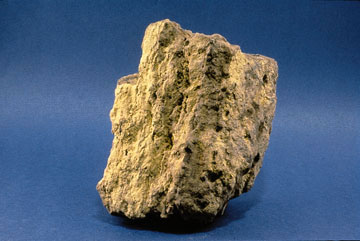Last week, we discussed some of the ways paleontologists order events in Earth’s history—using the principles of original horizontality, superposition, and faunal succession—but we did not talk about actual dates. Let’s do that now.
Who’s up for some chemistry?
Hopefully, you all know that matter is made up of atoms, which are in turn made up of electrons, neutrons, and protons. The number of protons determines the identity of the atom: 6 protons and you’re a carbon atom, 8 and you’re an oxygen and 92 and you’re uranium. But it turns out, just like colors come in different shades, there is more than one way to be any one of these elements.
A typical, standard atom of an element has the same number of neutrons in its nucleus as it has protons. Isotopes of an element, however, have a different number of neutrons than is standard. Standard, stable oxygen atoms, for example, have 8 protons and 8 neutrons. This is the case for 99.762% of oxygen atoms out there, but the other 0.238% of the time, a stable oxygen atom will have 8 protons and 9 or 10 neutrons. Note that I said stable oxygen atoms. Why is that important? Because there are isotopes of oxygen with fewer than 8 or more than 10 neutrons that are very unstable, meaning that they spontaneously break down and release energy. Atoms that do that are called radioactive.
When atoms undergo radioactive decay, their identity can change if their number of protons changes. Radioactive decay proceeds until a stable product is formed. Sometimes this takes many steps. A radioactive form of uranium, for example, uranium-238, or 238U, (238 being the sum of its protons [92] and neutrons [146] per atom and U being the chemical symbol for uranium), undergoes 14 decay reactions to reach its stable isotope, lead-206, or 206Pb (206 being the number or protons [82] and neutrons [124] per lead atom and Pb being the chemical symbol for lead).
But so what? How does this help us put a date on anything? Well, it just so happens that many of these decay reactions occur at a very stable and predictable rate. The rate of breakdown is so stable and predictable, in fact, that we can use the decay of radioactive elements as a kind of clock. The radioactive elements used to determine the ages of rock tick away steadily, with parent isotopes decaying and daughter isotopes accumulating at an even and measured pace, no matter the external conditions. Because we have verified these breakdown rates in the lab, if you can find the ratio of parent to daughter isotopes in a sample, and you have found out how long ago the clock was wound…with a couple of caveats.
 Caveat one: Things can get dicey if there isn’t sufficient amounts of both parent and daughter isotopes present in the sample to be accurately and precisely measured, usually via mass spectroscopy. Caveat two: Measurements are only reliable if no parent or daughter isotope has been added to or escaped from the system since the rock formed. Usually, this isn’t too much of problem, but it has to be kept in mind, especially when dealing with isotopes, such as potassium-40, that decay into gaseous products (in the case of potassium-40, argon-40). Another caveat is that when directly measuring parent:daughter isotope ratios, you have to assume that there was no daughter product present in the sample at its formation.
Caveat one: Things can get dicey if there isn’t sufficient amounts of both parent and daughter isotopes present in the sample to be accurately and precisely measured, usually via mass spectroscopy. Caveat two: Measurements are only reliable if no parent or daughter isotope has been added to or escaped from the system since the rock formed. Usually, this isn’t too much of problem, but it has to be kept in mind, especially when dealing with isotopes, such as potassium-40, that decay into gaseous products (in the case of potassium-40, argon-40). Another caveat is that when directly measuring parent:daughter isotope ratios, you have to assume that there was no daughter product present in the sample at its formation.
Luckily for paleontologists and geologists, none of these caveats are deal breakers. For one thing, there are many different radioactive elements that can be used to date rock material. Each of these elements has a different half-life. Half-life refers to the  time it takes for half of the radioactive atoms in a sample to decay to their stable daughter isotopes. Importantly, half-life is entirely independent of the sample size, so a huge hunk of U-238 has the exact same half-life as a tiny chip of U-238. The half-lives of different radioactive elements vary. The half-life of U-238 is 4.5 billion years (what? I didn’t say these were fast clocks!), for example, while the half-life of U-235 is a relatively short 713 million years. So if not enough time had elapsed for sufficient amounts of U-238 to decay and be measureable, U-235 might be used. Caveat #1: dealt with.
time it takes for half of the radioactive atoms in a sample to decay to their stable daughter isotopes. Importantly, half-life is entirely independent of the sample size, so a huge hunk of U-238 has the exact same half-life as a tiny chip of U-238. The half-lives of different radioactive elements vary. The half-life of U-238 is 4.5 billion years (what? I didn’t say these were fast clocks!), for example, while the half-life of U-235 is a relatively short 713 million years. So if not enough time had elapsed for sufficient amounts of U-238 to decay and be measureable, U-235 might be used. Caveat #1: dealt with.
Having multiple options also means that measurements can be checked against each other using more than one radiometric method. This helps to ensure accuracy and also serves as verification that no parent or daughter material has entered or left the system. So long caveat #2. As for the final caveat, that you have to assume no daughter isotopes present at the sample’s formation, there is a nifty methodology called isochron dating that obviates that assumption altogether. With isochron dating, scientists measure not only the ratio of parent to daughter isotope, but also the ratio of the daughter isotope to another isotope of that same element that does not form from radioactive decay. Perform some high school algebra and bingo bango, you get your answers—no assumption about the daughter isotope at the onset required. (For additional details on using isochrons, see this article from RNCSE.)
 But how do ratios and half-lives help us find out how something is? Well, let’s take a straightforward example. Say that the ratio of 238U:206Pb in a rock sample, which was known to have no Pb-206 at formation, is 15:1. What can we infer? We can infer that about 1/16th of the original uranium in the rock has decayed to lead, which means that about 1/8th of a half-life has elapsed, so the clock started in this rock 562.5 million years ago (1.5 billion x 1/8th = 562.5 million).
But how do ratios and half-lives help us find out how something is? Well, let’s take a straightforward example. Say that the ratio of 238U:206Pb in a rock sample, which was known to have no Pb-206 at formation, is 15:1. What can we infer? We can infer that about 1/16th of the original uranium in the rock has decayed to lead, which means that about 1/8th of a half-life has elapsed, so the clock started in this rock 562.5 million years ago (1.5 billion x 1/8th = 562.5 million).
Easy! So, all we have to do is get a fossil and do this isotope ratio thing, right? Wrong. I mean, you could, but you wouldn’t get the answer you’re looking for. Why? We’ll pick that up in Part 3.
Have an idea for a future Misconception Monday or other post? See some good or bad examples of science communication lately? Drop me an email or shoot me a tweet <at>keeps3.

